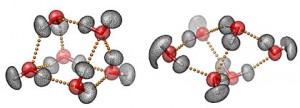The first session (Retrospect) this morning held a few surprises, i.e, unexpected speakers, Brian Greene and Ed Snowden (whistleblower re: extensive and [illegal or nonlegal?] surveillance by the US National Security Agency [NSA]). I’m not sure how Snowden fits into the session theme of Retrospect but I think that’s less the point than the sheer breathtaking surprise and his topic’s importance to current public discourse around much of the globe.
Snowden is mostly focused on PRISM (from its Wikipedia entry; Note: Links have been removed),
PRISM is a clandestine mass electronic surveillance data mining program launched in 2007 by the National Security Agency (NSA), with participation from an unknown date by the British equivalent agency, GCHQ.[1][2][3] PRISM is a government code name for a data-collection effort known officially by the SIGAD US-984XN.[4][5] The Prism program collects stored Internet communications based on demands made to Internet companies such as Google Inc. and Apple Inc. under Section 702 of the FISA Amendments Act of 2008 to turn over any data that match court-approved search terms.[6] The NSA can use these Prism requests to target communications that were encrypted when they traveled across the Internet backbone, to focus on stored data that telecommunication filtering systems discarded earlier,[7][8] and to get data that is easier to handle, among other things.[9]
He also described Boundless Informant in response to a question from the session co-moderator, Chris Anderson (from its Wikipedia entry; Note: Links have been removed),
Boundless Informant or BOUNDLESSINFORMANT is a big data analysis and data visualization tool used by the United States National Security Agency (NSA). It gives NSA managers summaries of the NSA’s world wide data collection activities by counting metadata.[1] The existence of this tool was disclosed by documents leaked by Edward Snowden, who worked at the NSA for the defense contractor Booz Allen Hamilton.[2]
Anderson asks Snowden, “Why should we care [about increased surveillance]? After all we’re not doing anything wrong.” Snowden response notes that we have a right to privacy and that our actions can be misinterpreted or used against us at any time, present or future.
Anderson mentions Dick Cheney and Snowden notes that Cheney has in the past made some overblown comments about Assange which he (Cheney) now dismisses in the face of what he now considers to be Snowden’s greater trespass.
Snowden is now commenting on the NSA’s attempt to undermine internet security by misleading their partners. He again makes a plea for privacy. He also notes that US security has largely been defensive, i.e., protection against other countries’ attempts to get US secrets. These latest programmes change US security from a defensive strategy to an offensive strategy (football metaphor). These changes have been made without public scrutiny.
Anderson asks Snowden about his personal safety. His response (more or less), “I go to sleep every morning thinking about what I can do to help the American people. … I’m happy to do what I can.”
Anderson asks the audience members whether they think Snowden’s was a reckless act or an heroic act. Some hands go up for reckless, more hands go up for heroic, and many hands remain still.
Snowden, “We need to keep the internet safe for us and if we don’t act we will lose our freedom.”
Anderson asks Tim Berners-Lee to come up to the stage and the discussion turns to his (Berners-Lee) proposal for a Magna Carta for the internet.
Tim Berners-Lee biography from his Wikipedia entry,
Sir Timothy John “Tim” Berners-Lee, OM, KBE, FRS, FREng, FRSA, DFBCS (born 8 June 1955), also known as “TimBL”, is a British computer scientist, best known as the inventor of the World Wide Web. He made a proposal for an information management system in March 1989,[4] and he implemented the first successful communication between a Hypertext Transfer Protocol (HTTP) client and server via the Internet sometime around mid November.[5][6][7][8][9]
Berners-Lee is the director of the World Wide Web Consortium (W3C), which oversees the Web’s continued development. He is also the founder of the World Wide Web Foundation, and is a senior researcher and holder of the Founders Chair at the MIT Computer Science and Artificial Intelligence Laboratory (CSAIL).[10] He is a director of the Web Science Research Initiative (WSRI),[11] and a member of the advisory board of the MIT Center for Collective Intelligence.[12][13]
The Magna Carta (from its Wikipedia entry; Note: Links have been removed),
Magna Carta (Latin for Great Charter),[1] also called Magna Carta Libertatum or The Great Charter of the Liberties of England, is an Angevin charter originally issued in Latin in June 1215. It was sealed under oath by King John at Runnymede, on the bank of the River Thames near Windsor, England at June 15, 1215.[2]
Magna Carta was the first document forced onto a King of England by a group of his subjects, the feudal barons, in an attempt to limit his powers by law and protect their rights.
The charter is widely known throughout the English speaking world as an important part of the protracted historical process that led to the rule of constitutional law in England and beyond.
When asked by Anderson if he would return to the US if given amnesty, Snowden says yes as long as he can continue his work. He’s not willing to trade his work of bringing these issues to the public forefront in order to go home again.
